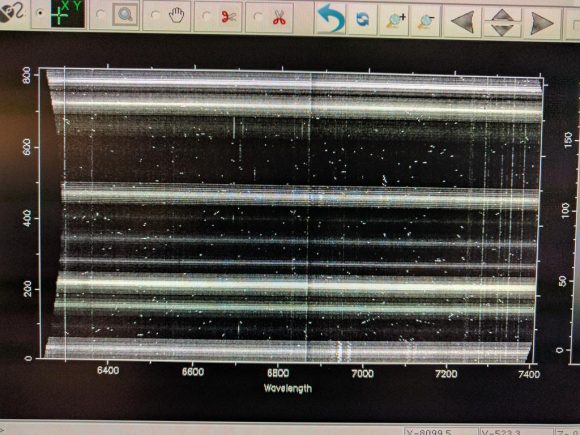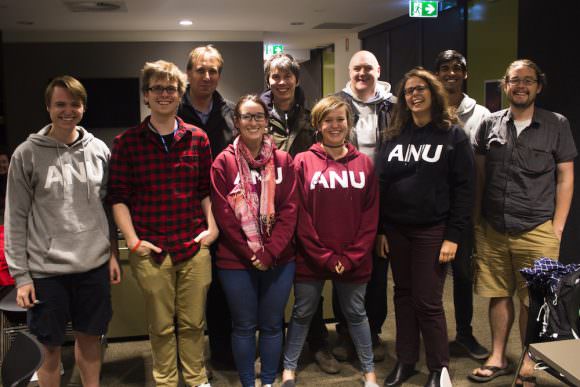A concentrated three-day search for a mysterious, unseen planet in the far reaches of our own solar system has yielded four possible candidates. The search for the so-called Planet 9 was part of a real-time search with a Zooniverse citizen science project, in coordination with the BBC’s Stargazing Live broadcast from the Australian National University’s Siding Spring Observatory.

Researcher Brad Tucker from ANU, who led the effort, said about 60,000 people from around the world classified over four million objects during the three days, using data from the SkyMapper telescope at Siding Spring. He and his team said that even if none of the four candidates turn out to be the hypothetical Planet 9, the effort was scientifically valuable, helping to verify their search methods as exceptionally viable.
“We’ve detected minor planets Chiron and Comacina, which demonstrates the approach we’re taking could find Planet 9 if it’s there,” Tucker said. “We’ve managed to rule out a planet about the size of Neptune being in about 90 per cent of the southern sky out to a depth of about 350 times the distance the Earth is from the Sun.

Last year, Caltech astronomers Mike Brown and Konstantin Batygin found indirect evidence for the existence of a large planet when they found that the orbits of several different Kuiper Belt Objects were likely being influenced by a massive body, located out beyond the orbit of Pluto, about 200 times further than the distance from the Sun to the Earth. This planet would be Neptune-sized, roughly 10 times more massive than Earth. But the search is difficult because the object is likely 1000 times fainter than Pluto.
The search has been on, with many researchers working on both new observations and sifting through old data. This recent project used archival data from the Skymapper Telescope.
“With the help of tens of thousands of dedicated volunteers sifting through hundreds of thousands of images taken by SkyMapper,” Tucker said, “we have achieved four years of scientific analysis in under three days. One of those volunteers, Toby Roberts, has made 12,000 classifications.”
Mike Brown chimed in on Twitter that he thought this concentrated search was a great idea:
@btucker22 @kbatygin @cosmos4u @BBCStargazing I would just like to say: you guys rock. We'd be thrilled if you find it!
— Mike Brown (@plutokiller) March 31, 2017
Tucker said he and his team at ANU will work to confirm whether or not the unknown space objects are Planet 9 by using telescopes at Siding Spring and around the world, and he encouraged people to continue to hunt for Planet 9 through Zooniverse project, Backyard Worlds: Planet 9.
Source: ANU


I’d like to know which four candidates were from the recent run. There was chatter of some picture series showing drift across the frame while others were individual spots and may have drifted off one picture to another.
For example here’s “three spots”
– https://www.zooniverse.org/projects/skymap/planet-9/talk/subjects/8438647
: green in the blue black area in far bottom left, then smaller red in black band that is next to the right, and blue in the red curved area top right center. They form a line.
Here’s a list of known objects they listed – https://www.zooniverse.org/projects/skymap/planet-9/talk/793/243564
Apparently there are 203 objects with RGB lines identified by users – could be anything including mistakes… https://www.zooniverse.org/projects/skymap/planet-9/talk/tags/RGBline
I worked on that project for a few hours. It was fun. I ran into the same issue with a few promising hits that ran off the corner/bottom/side of the screen on the first or last of the 3 images.
I think it was distinctly successful because the methodology was easy for people to learn and gave a real sense of seeing something – the colors indicating changing position. It did a great job for lots of kinds of people to contribute – old young, versatile in internet lingo and not. I hope a lot more come like this. I hope the people who developed this reflect on and expand such horizons.
I’m glad to see that three women astronomers are in on the hunt. If they help make the discovery, it would be a good day for women and girls in STEM.
Are you saying that you are surprised that women are contributing to science?
As for myself, and I imagine I speak for most male readers, I am not surprised at all and see no reason to separate them out from this Team effort.
I don’t think women are so far advanced as to have equal treatment and respect in the system. There are such posts as http://womeninastronomy.blogspot.com/2014/05/fed-up-with-sexual-harassment-serial.html
The days of “first woman” are past, the days of equality and fairness have not arrived and needs both more than figureheads and passing mention. There is a cultural problem and the culture has to deal with it. But astronomers cannot fix this by themselves. They grow old and die and new astronomers come in. So it is from, and back to, the cultural background of society that these things advance.
As I read the review the picture it seems there was only one woman astronomer on the team. The rest seems to be part of the BBC crew covering the event. Alas the telecast was not viewable in America. Whether they were working in astronomy as scientists or media production professionals, it is a data point in the graph of progress and hopefully a harbinger that more equality and respect will be forth coming.
BTW another project worth contributing to is https://www.planethunters.org/ about Kepler data